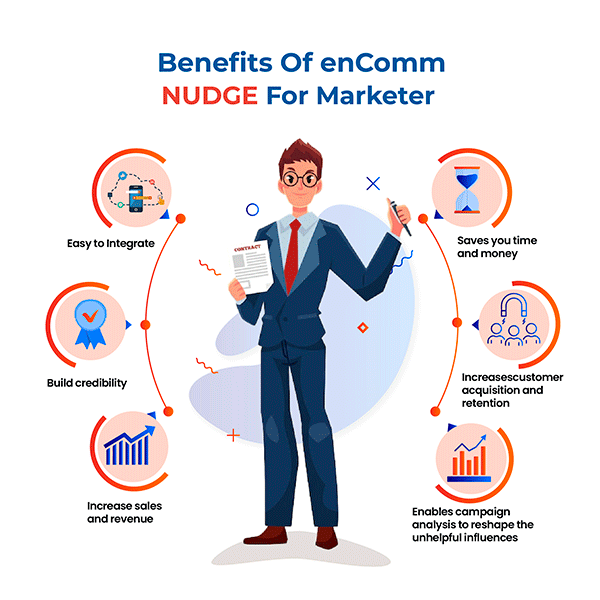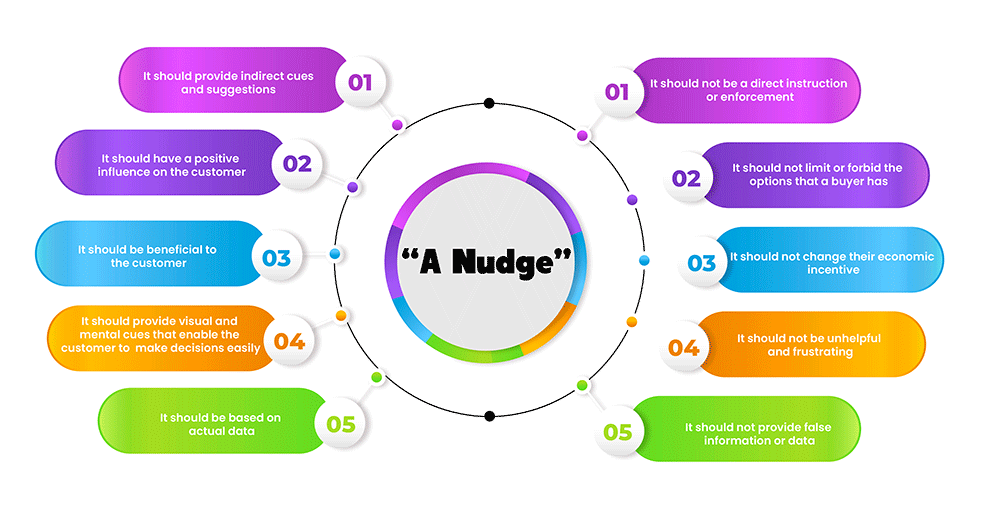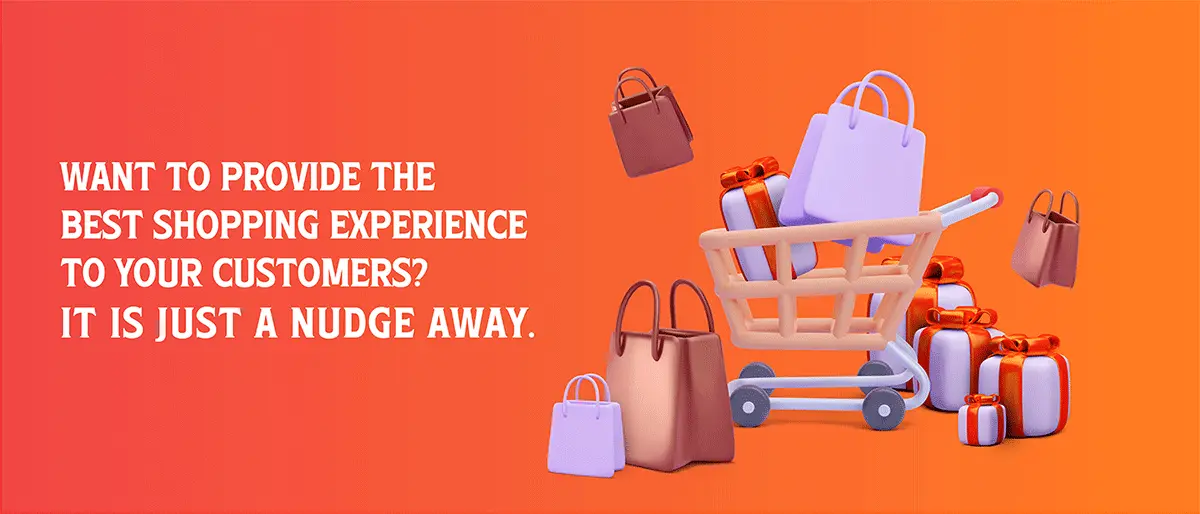Want to provide the best shopping experience to your customers? It is just a nudge away.
Nudging in general refers to the technique of gently coercing a person to make decisions or take steps towards a desired goal or outcome. In the e-commerce world, nudge techniques are often used as a marketing strategy to enhance the shopping experience of customers and to enable them to complete a purchase with ease.
What is Nudge Marketing?
Nudge Marketing is a strategy that prompts customers in a subtle yet effective way to make better purchasing decisions. It is the process of providing options, information, and suggestions that will influence the customers in a positive way driving them to complete a purchase. The information has to be designed in such a way that it appeals to the psychology of the buyer thereby making the purchase decision seem natural and easy. This form of marketing is considered to be more sustainable in gaining customer attention than offering discounts and freebies. It can also help reduce the number of abandoned carts.
Before we dive deep into Nudge Marketing techniques and their benefits let us first understand the theory behind nudging.
Nudge Theory
According to behavioral science concepts, it is possible to influence a person or a group of people through indirect suggestions and positive reinforcement. Nudge theory is based on this concept of psychological bias. Our brain is trained to take quick decisions based on visual cues and relevant information. This information will guide them to follow the desired behavior subconsciously.
Nudge theory in the past…..
Nudge theory was initially designed by academicians as an ethical concept to bring about change and improvement in society through subtle nudging rather than using enforcement or punishment.
For example, trying to change a student’s behavior through forceful methods will only lead to resistance and confrontation. Tactical nudge methods are not threatening or disruptive so students tend to cooperate.
When children are directed or commanded to clean up their rooms they resist doing it but when we suggest the same in a more fun way like playing “the cleanup game” with them then they are ready to clean up while having fun at the same time. This is what nudge is all about.
Nudge theory now…….
Nudge techniques and principles are now widely used in politics, education, business, marketing, social welfare, economics, etc. for influencing, and motivating groups of people to bring about change in their life as well as for others around them.
For example, there are so many wellness and fitness apps and social media platforms that gently nudge people to follow their suggestions and recommendations claiming to improve their lifestyle and health.
Marketing through Nudge techniques
In order to influence people we need to understand why people make certain purchasing decisions. It is important to analyze the way people think, react or behave when some information is provided to them. For example, When a customer is scrolling through a list of products, a simple message to point out, a product’s popularity among other customers or a product’s unique feature will influence the buyer to choose that product.
Two important concepts widely used in nudge marketing are Social proof and FOMO.
Social proof
When you shop for a product,
Do you prefer a product with a good rating over a product with no rating?
Do you choose a product because it is fast selling or highly recommended by others?
If your answer is yes, then the social proof on the page has influenced or rather convinced you to buy that product.
Social proof is the concept of herd mentality where people tend to follow the actions and recommendations of others to determine if their choice is right or wrong. Social proof helps people to make a choice when they are confused or don’t know what to choose. People tend to trust the recommendations from peers or fellow shoppers more than the people who market the product.
Social proof can be of different types like expert social proof, user social proof, celebrity social proof, and finally most important, recommendations from family and friends. Live sales notifications, ratings, product reviews, social media likes and shares, and testimonials from actual product users and bloggers are the best forms of social proof that can be used as a nudge.
Fear of missing out (FOMO)
When you casually browse through products,
Do you make a purchase because a popular product is selling fast and only a few are left in stock?
Do you make a purchase just because a sale is about to end in a few hours?
If your answer is yes, then you make a purchase because of the fear of missing out (FOMO). Due to FOMO, People would rather make a purchase than regret it later.
FOMO is the concept of creating urgency by displaying information that will trigger customers to make an impulsive purchase.
Even when a person is planning a future purchase, product campaigns that showcase a limited-time sale will create a FOMO and drive that person to make the purchase immediately.
All small and big e-commerce platforms use nudge campaigns to improve sales, conversions, and revenue.
Encomm Nudge uses both Social proof and FOMO to create nudge campaigns that can effectively convert visitors into customers and also improve sales and revenue.

Examples of Nudge techniques that are widely used to improve the conversion rate and sales
- Sales notifications pop-ups that show how many of the products have been sold recently.
You can easily create and customize your sales notification pop-up using enComm nudge. To start building your credibility and increase your revenue checkout enComm nudge
- Display the rating, feedback percent, and the number of reviews for a product at the top of the page to show the product’s popularity. Even displaying the text “Recommended” or “Best seller” on the product’s photo will establish the product’s popularity.
- Display product interest messages or pop-ups to show how many people have viewed or purchased the product or added it to their cart.
Drive your sales using enComm nudge’s product interest campaigns. Create a FOMO campaign that can be customized to show how many products have been sold in a particular time frame. The best feature in enComm nudge is the time slice option that can display the number of items sold, viewed and added to cart for the selected time frame. With enComm nudge you can not only create awesome campaigns but also analyze them and fine tune them.
All nudge pop-ups have to be dismissible so that they don’t cause any hindrance.
- Displaying stock-related information to show how many items are left in stock. This type of scarcity nudge creates a FOMO.
- Upsell and Cross nudges to guide people to buy more than one product for a lesser price.
- Offering free shipping for a particular purchase amount.
- Using a price anchor to show off the before and after the price of a product. Display the old price and new price side by side. Strike through the old price to show the customer’s savings.
- Displaying the testimonials and reviews on the landing page. Highlighting the top reviews with photos of the customers using the product.
- Displaying a countdown timer on the product page to indicate the time remaining for the expiry of the deal. It is good to set a time limit and stick to the sale expiry limit. If the expiry time is extended too often then the FOMO among customers is lost.
- Using exit-intent popups to nudge customers not to leave the product page. These pop-ups appear when the customer is about to close the tab or browser window.
- Displaying a checkout progress bar to show customers how many steps are left for the product purchase.
Do’s and Don’ts of Nudge

To conclude….
Nudge has to be a guidance without disturbing the customer’s freedom of choice. If the nudge is unhelpful and disturbing then it will only cause negative effects. Nudge marketing when done correctly can effectively enhance customer engagement, increase customer acquisition and retention, and reduce the number of abandoned carts.

